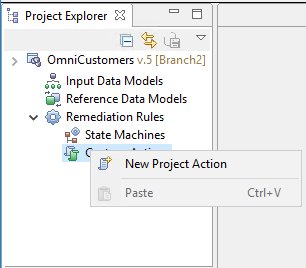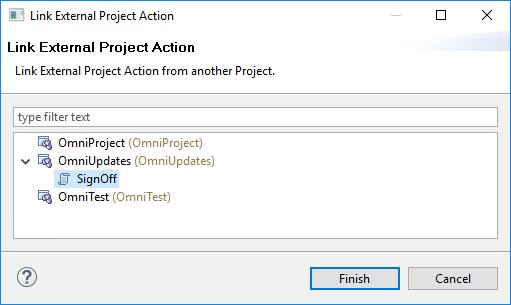Customizing Actions
|
Topics: |
Each action has Name and Icon attributes. Project Actions also have a Script attribute.
To add actions to state, you must drag and drop actions from the palette to the graph.
Viewing Project Actions
Project Actions you create are stored locally.
The Project Actions are created in the Project Explorer, under the Custom Actions node of the Remediation Rules. After double-clicking a Project Action, a Java Script editor opens for editing the script of the Project Action .
In the graph palette, all Project Actions should be displayed under the Custom Actions section. The Action icon is displayed by the name of the action. You can drag and drop Project Actions to any state's On Entry or On Exit section.
When viewing the properties, an extra tab icon is available if you wish to change the icon of the action.
Viewing Embedded Actions
Action descriptions are stored in the Configuration files of the server. You can use the endpoint to retrieve those actions together with other action types, display names, and short descriptions (currently, long descriptions are not available since there is no place to display them in palette). The Action list corresponds to the list from the Remediation Services of a specific version.
Actions are displayed in the Action palette as a list (for the StateMachine Editor). The items contain icons corresponding to the icon type and are loaded automatically when the editor is first opened for a project. The icons will be retrieved from the cache when the editor is reopened. The Action list is stored per Eclipse session and will have to be loaded again each time the editor is opened. Actions are similar to artifacts in that their availability can be tracked. You can also click the refresh button in the top right corner of the panel.
A progress notification appears in the palette whenever the palette is loading. You can press Reload if the following error message appears inside the palette:
Actions could not be loaded from the server.
The drag-and-drop feature is also enabled. When an action object is added to a graph, the name and short description from the action is brought along with it.
When viewing properties, the original name is displayed in a separate tab, similar to the Project Action, but it is not editable. All other properties can be edited.
Linking Remote Project Actions
The Linked Project Action option enables an action from a shared project to be linked and used on another project. Both projects must be on the same development.
If the selected project is not shared, the Link Remote Project Action option in the Custom Actions context menu will not appear, as shown in the following image.

Once the project is shared, the Link Project Action will appear in the Custom Actions context menu, as shown in he following image.

You can only link project actions when a project is shared with the same development server as the selected project. Each entity will have a shared property enabled by default, which means only those entities can be shared.
When you click Link Remote Project Action from the context menu, the corresponding Link Action wizard opens with a list of all Omni Designer projects shared with the same development server, as shown in the following image.

You can link an Action only from a project that is checked out from the server to the local workspace and does not contain any uncommitted changes, and no validation errors. A Linked Remote Project Action (Linked Project Action) does not depend on the local project, so a local project can safely be removed after an Action was linked. Information about Linked Remote Project Action (Linked Project Action) such as global project ID, version, and branch, will be stored in a wrapped object. This information helps to identify an Action on the server.
The following will be copied from the original Action:
- Name
- Long/short description
- Icon
- Script
- Shared properties
You can also link the Linked Remote Project Actions, and change the name, long/short descriptions, shared flags, and icons of a Linked Project Action.
The Linked Remote Project Action should be selected in the graph. You can also use a linking icon and show it in the tree or Project Explorer if possible.
You can also be notified if there are any changes to the original Action. Changes can be applied to a Linked Remote Project Action through an update (specific update), when viewing the Artifacts page implementation.
Viewing properties are the same as for Project Actions. On a separate tab, you can show information about the source project, version, name, and short/ long description. They cannot be edited.
Cutting, Copying, Pasting, and Moving Custom Actions
Cutting, copying, and pasting actions will work only from the Project Explorer. Currently, in this release, you cannot cut, copy, and paste from the edits since cutting, copying, and pasting of fields and plans, etc., are not supported. However, you can still make multiple cutting, copying, and pasting processes.
Moving Actions is the same as cutting and pasting, but you can move only within the Project Explorer. Making multiple moves are enabled.